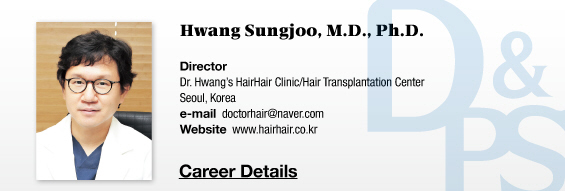When separating the scalp tissue resected from a donor site, the scalp tissue is separated with a surgical scalpel blce No. 10 or No. 20 on a smooth birch wood chip (Figure 1).

Figure 1. Separating hair follicles per follicular unit
First, the scalp tissue is divided thin and long (slivering, Figure 2) and then to each follicular unit. The separated perifollicular tissue may not be inserted well into the needle of the hair transplanter when separated too chubby, or have reduced survival rate due to hair follicle damage when separated too skinny. Separating them to a proper thickness is important (Figure 3).
[Advertisement] Reandnè Thread Series – Manufacturer: GTG KOREA(www.gtgkorea.com)

Figure 2. The scalp tissue can be easily separated by dividing them thin and long and then to each follicular unit.

Figure 3. Separated follicles
This process is performed by follicular separation technicians. Experienced technicians are needed to minimize follicular damage, but inexperienced doctors may rather increase the damage. The process requires both experience and concentration; it takes about 2 hours on average for 5-6 technicians to separate 3,000 hairs. Tough scalp tissue or thin hair may increase the difficulty of the process, causing the technicians feel fatigued more easily, and the time require for the separation.
A microscope or magnifying glass is often used for separation of follicles from westerners, whose hair is thin and have little color contrast against the skin, making it difficult to differentiate with the naked eye. On the contrary, Korean patients have thick hair, with marked color contrast compared to the skin, allowing the separation process only with the naked eye. A magnifying glass would be also beneficial for more reducing the follicle damage in Koreans as well (Figure 4).

Figure 4. Follicular separation process using a digital video microscope
Even experienced technician may sever follicles during the separation, in which case the severed follicles should not be discarded because many of them still have hair growth once transplanted.
The separated follicles are stored in cold normal saline until performing the transplantation. There are various kinds of preservation solutions, including cell culture medium, available for long-term preservation of the separated follicles, but normal saline is just enough, without much difference in the survival of the follicles between normal saline and cell culture medium, when performing the procedure is expected to be finished within 6 hours. Storing the normal saline in a refrigerator at 4℃, rather than in room temperature, is beneficial for the survival rate of the follicles. Because lowering the temperature of the normal saline close to 0℃ by placing on an ice pack may damage the follicles, the storage container should not be placed in direct contact with an ice pack.
Placing the separated on a gauze soaked with normal saline is better than placing them completely immersed in normal saline (Figure 5). Follicles placed in normal saline for a long time may have the tissue inflated, preventing smooth transplantation and even reducing the survival rate.

Figure 5. Separated follicles are stored by placing on a gauze soaked with normal saline.
In case of gray hair, it may not be easy to differentiate hair follicle from dermal tissue because the follicles are also gray, increasing the likelihood of damaging or severing the follicles during separation. Having gray hair at the recipient site may also raise the possibility of damaging the existing hair follicles during the transplantation (Figure 6). In order to prevent such problems, I instruct my patients with gray hair to dye their hair 2 days before the procedure. Black dyed hair can be helpful as a guideline for visualizing follicles during the separation process as well as for transplanting in empty spaces so that a damage to the existing hair could be avoided. Care should be taken when separating the follicles of undyed hair in patients with a history of allergic reaction to dye.

Figure 6. A patient with a lot of gray hair
(A: Donor site, B: Recipient site
C: Separated follicles: Black hair (right) has black follicle, but dyed black hair still has white follicle (left).)
- To be continued -
▶ Previous Artlcle : #7. Donor Harvesting Technique
▶ Next Artlcle : #9-1. Donor Harvesting Technique: FUS(S) VS. FUE





















